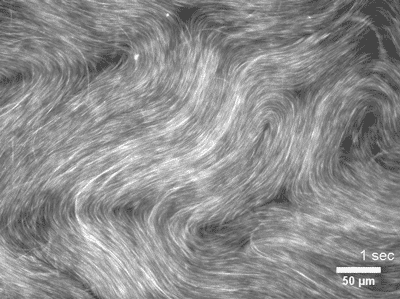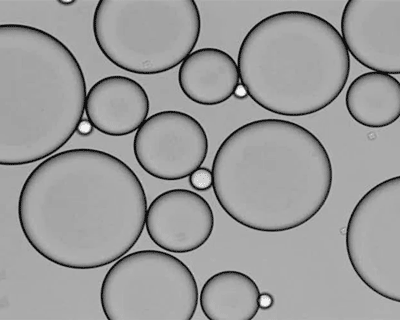Magic in the lab is no sleight of hand
Gil Henkin '14 is a physics major, but that doesn't prevent him from working magic. In the lab in 222 Abelson, the young scientist conjures mesmerizing images of microscopic systems in motion.
Under the guidance of Zvonimir Dogic, associate professor of physics, and alongside a team of postdoctoral fellows, graduate students and undergraduates, Henkin explores natural phenomena that seem almost magical: a school of fish swimming in perfect unison. A flock of birds performing a synchronized dance across the sky. Thousands of cars, trucks, motorcycles and bicycles flowing smoothly in Ho Chi Min City, without traffic lights, stop signs or police directing the way.
These are some of the systems Dogic's lab explores—on a much smaller scale.
On any given day, the lab is abuzz with quiet activity. One student hunches over a computer, fiddling with data; another squeezes polymer solution into small plastic tubes; a third catches a quick nap on an old, white couch squeezed into a narrow office shared by four graduate students.
The lab reflects Dogic's laid-back attitude—a place where laughter and data are traded equally, where the plaid shirt has replaced the white coat as lab uniform.
Dogic's team aims to discover the physical rules that govern systems of active matter, objects exhibiting self-organization or coordinated behavior. On a large scale, those systems can be flocks of birds, schools of fish, gaggles of geese or crowds of humans—any sort of group that moves and organizes itself. On a small scale, those systems can look like this:

This system, designed by Dogic's lab, is made up of bundles of hollow, tube-like structures called microtubules, which are propelled by kinesin motor proteins. The proteins walk along the microtubules on two leg-like structures, sliding one microtubule filament away from another. The bundles move together in one direction, then another. Why? How? What rules govern this system of movement? Dogic and his team are beginning to answer these questions.
How does the movement of microtubules relate to schools of fish or flocks of birds? Take that active matter, those self-propelled bundles, and contain them inside a droplet of oil in water. The microtubules begin to propel the droplet.

The droplets are now simple self-propelled particles.
"What are birds or fish if not self-propelled creatures?" asks Stephen DeCamp, a graduate student in Dogic's lab.
Watch how the droplets move. They are clumsy, constantly bumping into each other. There is no discernable pattern. Yet, the same physical rules governing these droplets may also govern schools of fish.
"The laws are universal," DeCamp says. "The rules of flocking behavior might be fundamental to governing any self-organized system, from bacteria to fish to humans."
Of course, the droplets are much simpler than birds or fish, containing only microtubules, kinesin proteins and a depletion agent to keep the bundles together. Yet that simplicity allows the lab to experiment with the system, to figure out how these small active matter particles may eventually become this:
It may look like magic, but it is science in action—and Dogic's lab is aiming to reveal the trick.
More information: More Dogic Lab videos here: www.youtube.com/user/DogicLab
Provided by Brandeis University


















